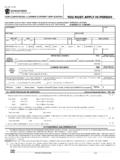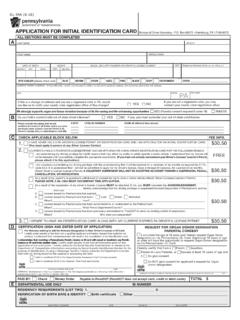Transcription of Questions and Answers - United States Department of ...
1 Questions and Answers Concerning the Final Rule Implementing the Housing for Older Persons Act of 1995 (HOPA) Title VIII of the Civil Rights Act of 1968 (the Federal Fair Housing Act), as amended by the Fair Housing Amendments Act of 1988 (the Fair Housing Act), prohibits discrimination in housing and real estate-related transactions based on race, color, religion, sex, national origin, handicap and familial status (in general, the presence of children under the age of 18 in the household). The prohibition against discrimination based on familial status became effective March 12, 1989. The Act contained a provision exempting "senior" housing from the prohibition against familial status discrimination.
2 The Housing for Older Persons Act (HOPA), signed into law by President Clinton on December 28, 1995, amended the housing for older persons exemption against familial status discrimination. The HOPA modified the statutory definition of housing for older persons as housing intended and operated for occupancy by at least one person 55 years of age or older per unit. It eliminated the requirement that housing for older persons have significant services and facilities specifically designed for its elderly residents. It required that facilities or communities claiming the exemption establish age verification procedures.
3 It established a good faith reliance defense or exemption against monetary damages for persons who illegally act in good faith to exclude children based on a legitimate belief that the housing facility or community was entitled to the exemption. Question 1 For the purpose of HOPA, what is a housing community or facility? What are some typical examples of a housing, community or facility? Answer A housing community or facility is any dwelling or group of dwelling units governed by a common set of rules, regulations or restrictions. A portion of a single building may not be considered a housing facility or community.
4 Typical examples include: a condominium association; a cooperative; a property governed by homeowners or resident association; a municipally zoned area; a leased property under common private ownership; a manufactured housing community, a mobile home park. ** HUD INTERNET VERSION ** 2 Question 2 May an owner of single family houses that are dispersed throughout a geographical area, and who is not otherwise exempt under the Fair Housing Act, qualify as a "housing community or facility" and claim the exemption? Answer No. The common use of the terms "housing community" and "facility" applies to dwelling units which are in the same location and have some relationship to each other.
5 The dwelling units in a housing community or facility must share a common set of rules, policies, and procedures, that is applied to all of the dwellings in the community or facility. Further, although there is no required stated minimum number of dwelling units that must be present for the exemption to apply, there must be a sufficient number of dwelling units to constitute a "community" or "facility" in the common meaning of those terms. One single family dwelling or a duplex would not qualify as a "housing community or facility." Question 3 What must a housing community or facility do to qualify for the 55 or older housing for older persons exemption?
6 Answer In order to qualify for the exemption, the housing community/facility must satisfy each of the following requirements: a) at least 80 percent of the occupied units must be occupied by at least one person 55 years of age or older per unit; b) the owner or management of the housing facility/community must publish and adhere to policies and procedures that demonstrate an intent to provide housing for persons 55 years or older; and c) the facility/community must comply with rules issued by the Secretary for verification of occupancy through reliable surveys and affidavits. Question 4 ** HUD INTERNET VERSION ** 3 What are some examples of the types of policies and procedures that would demonstrate an intent to provide housing for persons 55 years of age or older?
7 Answer Examples include: a) the written rules, regulations, lease provisions, deed or other restrictions, b) the actual practices of the owner/management of the housing facility/community used in the enforcement of the rules; c) the kind of advertising used to attract prospective residents to the housing facility/community as well as the manner in which the facility/community is described to prospective residents; d) the housing community's/facility's age verification procedures, and its ability to produce, in response to a familial status complaint, verification of required occupancy. Question 5 May a housing facility or community advertise as "adult" housing and still demonstrate the intent to be housing for older persons?
8 Answer Use of the word "adult" or "adult community" in an advertisement, sign or other informational material, or when describing the facility or community to prospective renters or purchasers or members of the public, does not demonstrate an intent to be housing for older persons as defined by the final rule. The use of these terms, on the other hand, does not destroy the intent requirement of HOPA. If a facility or community has clearly shown in other ways that it intends to operate as housing for older persons, and meets the 80% requirement, and has in place age verification procedures, the intent requirement can be met even if the term "adult" is occasionally used to describe it.
9 The Department will look at the totality of the circumstances in the investigation of a complaint alleging that the facility or community does not qualify as housing for older persons. ** HUD INTERNET VERSION ** 4 Question 6 How many days after the effective date of the final rule implementing HOPA does a facility/community have to develop routine procedures for determining the occupancy of each unit, including age verification? Answer The housing community/facility has 180 days after the effective date of the rule, May 3, 1999, to develop the appropriate procedures that should constitute a part of its normal leasing and purchasing procedures.
10 However, if a housing facility or community is not now but intends to become eligible for the exemption, it should not delay development of appropriate procedures. Question 7 What information should a housing provider include in its survey of residents in order to calculate whether the community or facility meets the 80% requirement of HOPA? Answer The owner or manager should obtain the total number of units in the housing community or facility. From that number, the following units should be excluded from the calculation of the 80% requirement: a) the number of units that have been continuously occupied by the same household since September 13, 1988, and the household did not contain and does not currently contain at least one person over the age of 55; b) the number of unoccupied units (see question 22).












